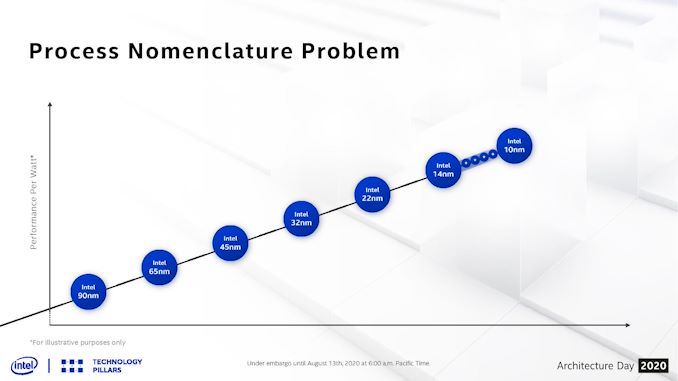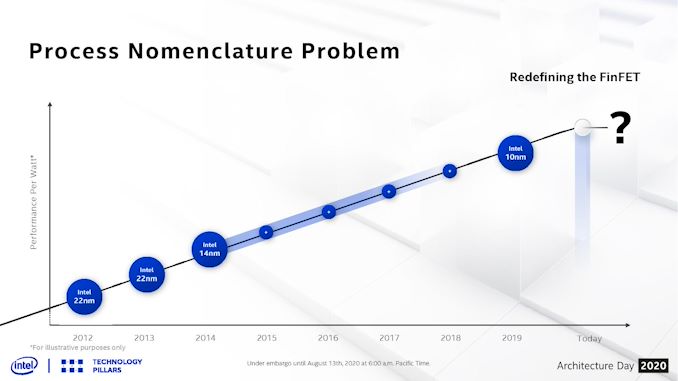What Products Use Intel 10nm? SuperFin and 10++ Demystified
by Dr. Ian Cutress on September 25, 2020 9:00 AM EST_678x452.jpg)
For our audience that regularly keeps track of Intel’s product portfolio, it would be hard to miss that the naming strategy of Intel’s process node technologies is a bit of a mess. To some, those words are themselves an understatement, as Intel has shifted its naming strategy 2-3 times since the launch of Intel’s first 10nm products. Not only that, even Intel’s various departments internally have a hard time keeping track of ‘what is this manufacturing process being called today’ when the press like AnandTech ask for details on the latest upcoming products.
Knowing this, and knowing what issues Intel has been having, I wanted to demystify Intel’s manufacturing process naming scheme such that users and engineers alike, even if they are inside Intel, can understand what is what but also importantly why. The why is the crucial factor.
If you're looking for a handy decoder ring for Intel's 10nm Products, it's here in page 3.
Why Do We Have Multiple Versions of a Process?
With Intel’s 14nm, we were invited to 14nm, 14+, 14++, 14+++, and if you believe Intel’s own slides, there were variants that went beyond this ++++ naming scheme. Each one of those additional + points on the end of the name signified a change in the process technology – usually to assist for increasing performance or efficiency.
Each one of these + points is an update to the BKM, or Best Known Methods.
While an engineer can draw an electrical layouts for a part of a processor, such as an addition circuit, actually applying that design to a silicon floorplan for manufacturing is a different skill altogether. Transistor libraries are designed to take advantage of a given process, and when a floorplan is optimized for a process, it can then be pasted and repeated as necessary – on top of this, simulation on thermals, power, and current density are applied to ensure that there are no hotspots or that critical paths inside the design have as few bottlenecks as possible.
When an update to the BKM occurs, two things can happen. Normally we see the update on the level of the transistor library that is changed – if the distance between two fins on a transistor increases for example, the transistor library and the macros may be made bigger, and then the floorplan might be redesigned to take account for this. As for any process node design, there are 100 different controls, and improving one might make three other controls worse, so it is a fine balancing act. Not only this, but the BKM has to be validated at the manufacturing level. The BKM update could apply to the metal stack as well, which in of itself can adjust the performance.
In the long long past, BKM updates were never advertised externally. If Intel or TSMC or another foundry discovered a way to improve the performance, or decrease the voltage, or improve the yield, the update was silently rolled into the design and nothing much was made of it. Sometimes processors would be listed as ‘1.0 volts to 1.35 volts’, and it would just be a roll of the dice if a user obtained one of the lower voltage models.
However, as time between different process node updates has elongated, these BKM updates have started to be identified and effectively monetized by the semiconductor companies. An update to a process that improves the voltage by 50 millivolts and increases frequency by 200 MHz immediately becomes a productizable event, and products built on these updates can be offered for more money over the usual. Or, depending on the rate of updates, the whole next generation of products could be built on the update.
So we never saw BKM updates officially announced at Intel’s 45nm, 32nm, or 22nm process nodes. These updates were fast enough that the productization of any update didn’t warrant a full round of marketing. With 14nm, that changed.
Intel had discussed its roadmap beyond 14nm since its 2010 Investor Meeting. It predicted that the company would be on 14nm by 2013, 10nm by 2015, and 7nm by 2017. As we now know, 14nm was two years late, and 10nm was 2-4 years late. Because of the introduction of 10nm being delayed, Intel decided to productize its 14nm BKM updates, and signified those with + points.
Intel’s current official line is that there have been four updates to 14nm, creating five ‘generations’.
More Plus Means More Meme
Because of all the + points, Intel’s marketing sometimes getting it wrong, and perhaps a little bit of ‘++’ in most programming languages meaning ‘+1’, the whole concept of adding + to the process node has become a meme – a meme at Intel’s expense, purely on the basis of its failure to deliver 10nm before the 14++++ naming scheme got out of hand.














143 Comments
View All Comments
velanapontinha - Saturday, September 26, 2020 - link
This!lilo777 - Friday, September 25, 2020 - link
It is stupid to criticize Intel for delivering a microprocessor that offers OEMs a flexibility to optimize the parameters for different use cases. If you want to know the performance, ask the OEMs (or don't be lazy and read the reviews).Spunjji - Friday, September 25, 2020 - link
Not stupid at all. It's entirely within their power to enforce certain design parameters. It's to their benefit not to, though - this way they can upsell higher-performing CPUs to unwitting consumers more easily.lilo777 - Friday, September 25, 2020 - link
Enforce what? Don't be ridiculous. Besides, system performance depends on many factors, not just CPU anyway. Whoever is buying a computer based solely on the CPU SKU deserves whatever they are getting anyways.Spunjji - Monday, September 28, 2020 - link
"Enforce what" - minimum performance / cooling standards? It's not that hard, Intel already have a bunch of standards that OEMs must adhere to. No validation, no sticker, done.Here's a bizarre idea - you could even have separate model numbers for OEMs to use depending on the performance their implementation is capable of. To pluck an idea out of thin air, you could add a U on the end for the ultra-low-power and add an H for high-performance. 😏
The rest of your post is just waffle. System performance depending on many factors doesn't mean it's okay to sell CPUs that perform differently under the same damned product name. Saying "it's up to the customer" doesn't absolve Intel of that deception in the first place. Next you'll be trying to sell me on your "multi-level marketing" scheme, caveat emptor.
Everett F Sargent - Friday, September 25, 2020 - link
Intel® Core™ i7-4770K Processor (4th Generation)https://ark.intel.com/content/www/us/en/ark/produc...
Q2'13, 22+ nm
Intel® Core™ i7-4790K Processor (4th Generation)
https://ark.intel.com/content/www/us/en/ark/produc...
Q2'14, 22++ nm
Intel® Core™ i7-5775C Processor (5th Generation)
https://ark.intel.com/content/www/us/en/ark/produc...
Q2'15, 14 nm
Intel® Core™ i7-6700K Processor (6th Generation)
https://ark.intel.com/content/www/us/en/ark/produc...
Q3'15, 14+ nm (could not readily get one ubtil Q1'16, they sold the i7-4790k during that holiday season)
Intel® Core™ i7-7700K Processor (7th Generation)
https://ark.intel.com/content/www/us/en/ark/produc...
Q1'17, 14++ nm
Intel® Core™ i7-8700K Processor (8th Generation)
https://ark.intel.com/content/www/us/en/ark/produc...
Q4'17, 14+++ nm (ditto holiday season availability as for the 6th Generation)
Intel® Core™ i9-9900K Processor (9th Generation)
https://ark.intel.com/content/www/us/en/ark/produc...
Q4'18, 14++++ nm (ditto holiday season availability as for the 6th/8th Generations)
Intel® Core™ i9-10900K Processor (10th Generation)
https://ark.intel.com/content/www/us/en/ark/produc...
Q2'20, 14+++++ nm
Intel® Core™ i9-11666K Processor (11th Generation aka Rocket Lake)
https://ark.intel.com/content/www/us/en/ark/produc...
Q2'21 (tbd), 14++++++ nm
Intel® Core™ i9-12666K Processor (12th Generation aka Alder Lake)
https://ark.intel.com/content/www/us/en/ark/produc...
Q4'21 (tbd), 10 nm (ditto holiday season availability as for the 6th/8th Generations, widely available Q2'22)
Seven generations of 14 mn in seven years (on average) aka a one year cadance. Seven 14 mn generations in seven years! :(
Ahsan Qureshi - Friday, September 25, 2020 - link
5775C is 14nm, not 22nm++. 4770K and 4790K are fabricated on the same 22nm process. There is no 22nm+ or 22nm++..Everett F Sargent - Friday, September 25, 2020 - link
Process size follows generation in all cases, so 14 nm comes after 5775C. My nomenclature is very simple, each generation starts with no "+" subsequent nodes are appended with a "+" for each subsequent generation, so that 14++++++ is the 7th generation at 14 nm.If Intel can play the name game to hide their seven year stall at 14 nm and now at what appears to be 10 nm, perhaps Intel should just drop the XX nm altogether, go with 7XL for Rocket Lake and L for Alder Lake, when they get to 7 nm it would be M and 5 nm would be S.
Face it, Intel has so scotched up all their processor names and node names to date, Bronze, Silver, Gold and Platinum, G, L, X, K, KF, R, MX, XM, T, F, H, KFA and TKFC (Totally Krispy Fried Cooker). Intel has more processor and node names then they do processors!
Fulljack - Friday, September 25, 2020 - link
not true, both Broadwell (5775C) and Skylake (6700K) are built on the same 14nm process—probably a "slightly" optimized one, but Broadwell is based on Haswell that is process node shrink (Tick) while Skylake is based on new architecture (Tock).Spunjji - Friday, September 25, 2020 - link
Incorrect. Broadwell was the "first crack" at 14nm and Skylake's 14nm variant had improved characteristics on the process front, as well as a newer architecture. Yields for Broadwell were not as good, and it needed higher voltages, while high clocks were not as easily attainable as on a similar core design at 22nm (Hardwell). The process improvements ameliorated those issues.